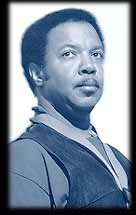
|
|
|
|
|
|
Photo Credit: Steve Maruta |
Ron Holloway
Fiery tenor saxophonist Ron Holloway combines passion and a broad dynamic range to generate an exciting and distinctive sound. Employing great technical facility, Holloway joins a long tradition of jazz musicians who have extended the limits of their instruments. As an exhilarated audience welcomes this Washington, DC native to the stage of the Kennedy Center’s Theater Lab, he responds with a hard-hitting and soulful rendition of "What Is This Thing Called Love". After the applause settles, Holloway tells Dr. Taylor about his family’s love for jazz music. Acknowledging his parents in the audience, he says, "I was exposed [to jazz records] from the time I came out of the womb…" When he was first learning to play in the early 70’s, Holloway looked to players like Willis "Gator Tail" Jackson and Hank Mobley, because their approach was very accessible to younger players like himself. But Holloway soon discovered Sonny Rollins, his long-time hero and primary influence to this day. Among many other things, Holloway admires Rollins’ sense of drama and the fact that he strives to maintain his individuality. Regarding individuality, Billy recalls Rollins paying a compliment to Holloway when critics suggested that Holloway’s playing sounded like Rollins. Sonny replied, "I don’t think so...I think he sounds like himself". Billy invites Holloway to exhibit his unique style with his own composition titled "Slanted", a dynamic blues number. Like Rollins, Holloway strives to push the tenor sax beyond the limits of its dynamic range. He notes that the instrument was originally designed to play a range of two and a half octaves. By using special fingering techniques, Holloway can hit registers spanning almost five octaves. Holloway demonstrates his extraordinary range while maintaining precise control over a melody. As Holloway hits the highest register, Dr. Taylor remarks, "That’s amazing to me". Noting some of Holloway’s more contemporary influences, Billy suggests playing Herbie Hancock’s "Cantaloupe Island". Holloway gradually builds a solo from a low-pitched and mellow intro into a high-pitched frenzy. Later, Billy asks Holloway to explain the process of constructing a solo that makes a strong personal statement. Holloway says he tries to incorporate elements of the masters’ tradition while striving to draw in his own unique elements, such as the texture of his sound and choice of note sequences. Billy notes that Holloway had quite an influential teacher in trumpeter Dizzy Gillespie. Holloway played in Gillespie’s quintet from 1989 until Dizzy’s death in 1993 and gleaned many invaluable lessons through his contact with the main architect of bebop. Among these lessons, he mentions watching Gillespie’s mastery of leading a band, how he would pace material, and how well he could read an audience. As usual, the audience provides insightful questions for Dr. Taylor and his guest. One member asks for a technical definition of a "ballad". Billy explains that ballads are different in that they rely less on rhythm for their development, but are more lyrically and melodically based.
Returning to the bandstand, Holloway hits his entire range on Rollins’ "Everywhere Calypso", thus paying tribute to his idol. Then Holloway and Billy’s trio bring the house down with an extra funky version of Thelonious Monk’s "Epistrophy" to close out the show.
|
|
| |
